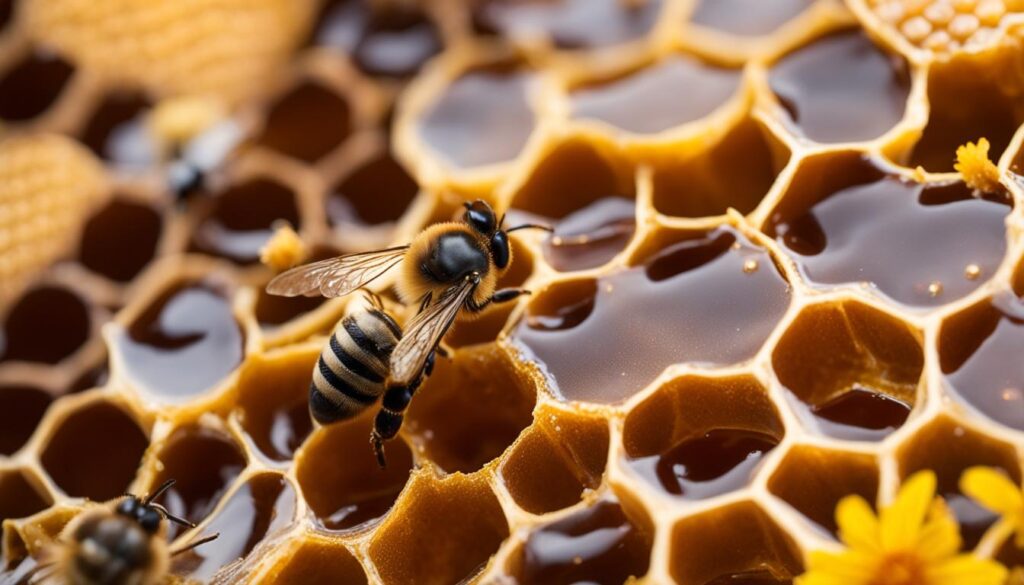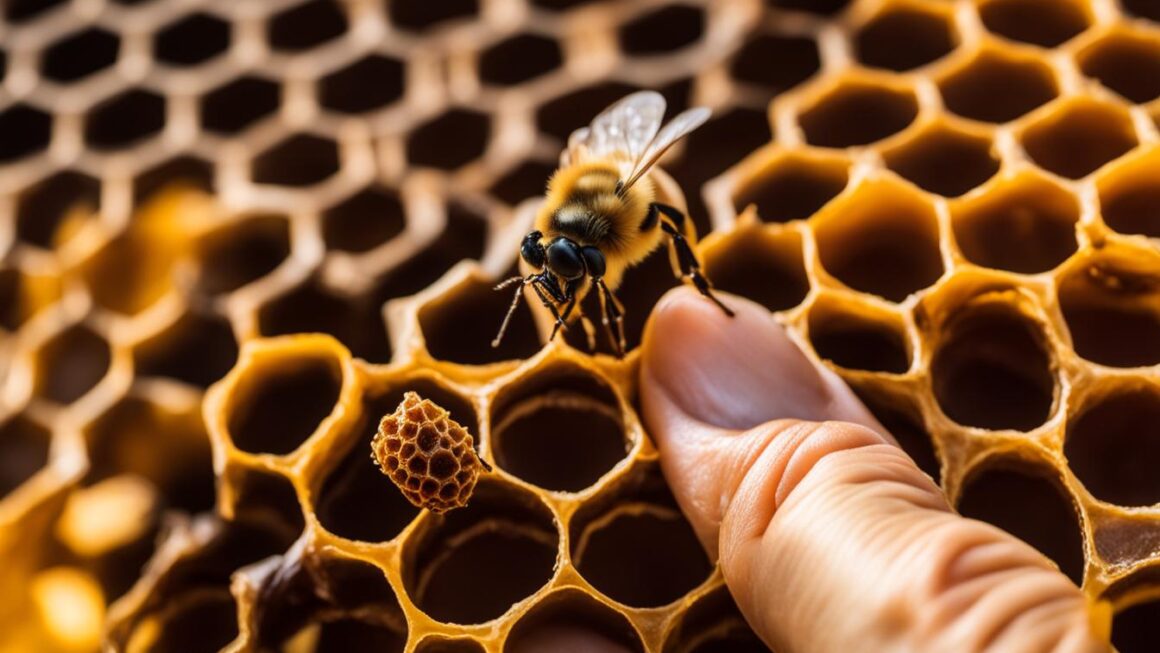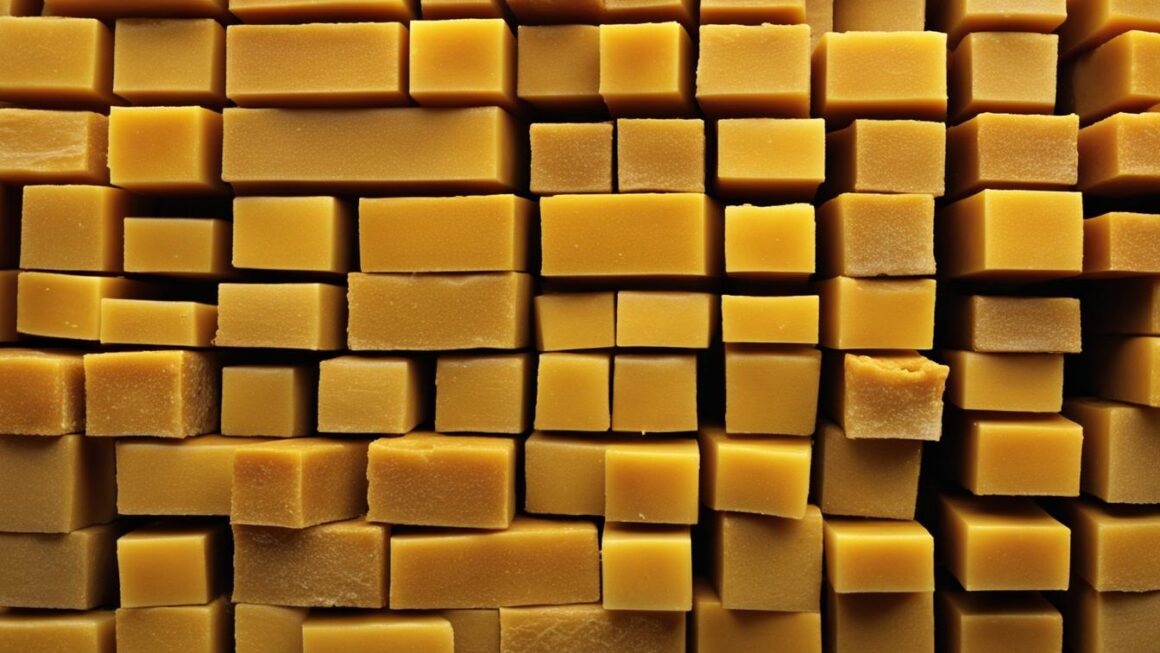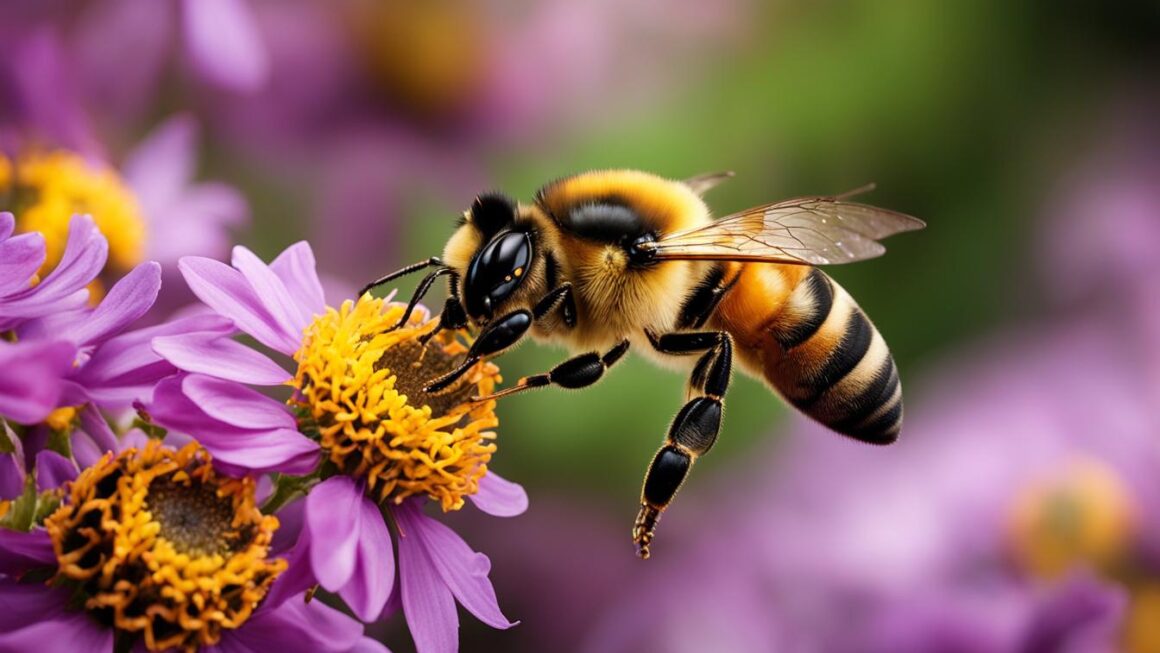Consuming raw honeycomb made from beeswax can have health benefits, but it can also pose some risks if consumed in large amounts. Honeycomb is a natural product made by bees to store honey and pollen, and it contains raw honey, bee pollen, propolis, and royal jelly. Raw honey is rich in carbohydrates, antioxidants, enzymes, and polyphenols, which promote health and reduce inflammation.
Honeycomb may promote heart health, protect against infections, reduce coughing in children, and be a potential sugar alternative for people with diabetes. It may also improve liver function. However, caution should be exercised as honeycomb can be contaminated with C. botulinum spores and may cause stomach obstructions. People with allergies to bee venom or pollen should also use caution when consuming honeycomb.
Key Takeaways:
- Consuming raw honeycomb can have health benefits.
- Raw honeycomb is rich in carbohydrates, antioxidants, enzymes, and polyphenols.
- Honeycomb may promote heart health and protect against infections.
- Caution should be exercised due to the potential for contamination and stomach obstructions.
- People with allergies to bee venom or pollen should use caution when consuming honeycomb.
What is Honeycomb?
Honeycomb is a natural product created by bees to store honey and pollen or house their larvae. It is made up of hexagonal cells constructed from beeswax and contains a combination of raw honey, bee pollen, propolis, and royal jelly in small amounts. Unlike commercial honey, which is pasteurized and filtered, raw honeycomb contains all the components of honey in their purest form. This includes the waxy cells, which can also be eaten. Raw honey provides various health benefits, while beeswax contributes heart-healthy long-chain fatty acids and alcohols.
In essence, honeycomb is a synergy of nature’s goodness. The hexagonal structure of the cells not only allows for efficient storage, but it also provides strength and stability. Beeswax, the material that makes up the honeycomb, is produced by the bees themselves. It serves as a protective casing for the precious honey it contains, as well as a safe haven for the development of new broods.
Consuming honeycomb allows us to enjoy not only the delightful taste of raw honey but also the additional components found within the comb itself. It is a testament to the remarkable ingenuity of bees and the wonders of the natural world.
What is Honeycomb?
Nutritional Value of Honeycomb
Honeycomb is not only a delicious treat but also packed with various nutritional benefits. Let’s explore the nutritional value of honeycomb and the components that make it a wholesome choice.
Carbohydrates:
Honeycomb is rich in carbohydrates, which provide the body with a quick and sustained source of energy. The carbohydrates in honeycomb mainly come from the raw honey it contains.
Antioxidants:
Honeycomb is a natural source of antioxidants. Antioxidants help protect the body from harmful free radicals and reduce the risk of chronic diseases. The antioxidants in honeycomb are derived from the raw honey, bee pollen, and propolis it contains.
Raw Honey:
Raw honey is the main component of honeycomb and is known for its numerous health benefits. It contains enzymes, polyphenols, and other bioactive compounds that promote overall well-being.
| Nutrient | Amount per Serving (100g) |
|---|---|
| Calories | 304 |
| Carbohydrates | 82g |
| Fat | 0g |
| Protein | 0.3g |
| Vitamin C | 0.5mg |
| Calcium | 0.2mg |
| Potassium | 52mg |
The nutritional value of honeycomb can vary slightly depending on the region, bee species, and floral source. It is important to note that honeycomb should be consumed in moderation as part of a balanced diet.
Overall, honeycomb offers a combination of carbohydrates, antioxidants, and other essential nutrients. However, it is essential to consider individual dietary needs and consult a healthcare professional if you have any specific concerns or conditions.
Health Benefits of Honeycomb
Honeycomb offers several health benefits when consumed in moderation. Its unique combination of nutrients makes it a valuable addition to a balanced diet. Here are some of the key health benefits of honeycomb:
- Promotes heart health: Honeycomb can contribute to better heart health by reducing “bad” LDL cholesterol levels, increasing “good” HDL cholesterol levels, and improving blood flow. These effects help in maintaining optimal blood pressure levels and reducing the risk of cardiovascular diseases.
- Provides antioxidants: Honeycomb is rich in antioxidants, which help protect the body against harmful free radicals and oxidative stress. Antioxidants also play a role in reducing inflammation and boosting the immune system.
- Protects against infections: The antimicrobial properties of honeycomb’s raw honey can aid in fighting off bacterial and viral infections. It can be particularly beneficial in relieving coughing in children due to its soothing properties.
- May be a sugar alternative: Honeycomb can serve as a potential sugar alternative for people with diabetes. It raises blood sugar levels less than refined sugar and may help reduce insulin resistance.
- Improves liver function: Some studies suggest that the compounds found in honeycomb, such as antioxidants and enzymes, may contribute to improved liver function and overall liver health.
It’s important to note that while honeycomb offers health benefits, it should be consumed in moderation. Excessive consumption may lead to stomach obstructions or other digestive issues. Additionally, individuals with allergies to bee venom or pollen should exercise caution when consuming honeycomb.
Overall, adding honeycomb to your diet can be a flavorful and nutritious way to support your overall well-being. As with any food, it’s best to consult with a healthcare professional or nutritionist to determine the appropriate amount for your individual needs.
Honeycomb Consumption Precautions
While honeycomb is generally considered safe to eat, there are some precautions to keep in mind to ensure your health and safety.
Allergies to Bee Venom or Pollen
Individuals with known allergies to bee venom or pollen should exercise caution when consuming honeycomb. Although allergic reactions to honeycomb are rare, it’s important to be aware of the potential risk and consult a healthcare professional if you have any concerns.
Risk of Contamination
Honeycomb can be at risk of contamination with C. botulinum spores, which can be harmful, especially to pregnant women and infants under 12 months of age. It is important to source honeycomb from reliable and reputable suppliers who follow strict quality control measures to minimize the risk of contamination.
Stomach Obstructions
Eating large amounts of honeycomb may cause stomach obstructions, particularly if consumed without chewing thoroughly. To prevent any discomfort or digestive issues, it is recommended to consume honeycomb in moderation and be mindful of your eating habits.
Precautions for Safe Consumption
To ensure the safe consumption of honeycomb, here are some additional precautions to keep in mind:
- Store honeycomb at room temperature in a sealed container to maintain its freshness and quality.
- Do not expose honeycomb to direct sunlight or high temperatures, as it may affect its texture and taste.
- If you prefer to freeze honeycomb for longer storage, ensure it is wrapped tightly to prevent freezer burn and thaw it properly before consuming.
By following these precautions, you can enjoy the unique flavors and potential health benefits of honeycomb while ensuring your well-being.
How to Use Honeycomb
Honeycomb is a versatile ingredient that can be enjoyed in various ways. Here are some suggestions on how to use honeycomb in your culinary creations:
1. Sweeten Your Treats
Raw honeycomb can be used as a natural sweetener in a wide range of desserts. Add chunks of honeycomb to homemade ice creams, cakes, or cookies for a delightful burst of sweetness. The golden, chewy texture of honeycomb adds a unique touch to your favorite treats.
2. Pair with Cheese and Chocolate
Honeycomb pairs exceptionally well with cheese and chocolate. Serve a platter of your favorite cheeses alongside slices of honeycomb for a delightful combination of flavors. Drizzle melted chocolate over chunks of honeycomb for an indulgent treat that will satisfy your sweet tooth.
3. Spread on Toast or Enjoy with Fruits
Spread a generous amount of honeycomb on warm toast or English muffins for a delicious breakfast or snack. The natural sweetness of honeycomb complements the crispy texture of toast perfectly. You can also enjoy honeycomb with fresh fruits like berries or sliced apples for a wholesome and refreshing treat.
4. Enhance your Charcuterie Board
Add honeycomb to your charcuterie board to elevate its flavors and textures. The combination of savory meats, creamy cheeses, and the sweet, chewy honeycomb creates a delightful contrast that will impress your guests. It adds a touch of sophistication to any charcuterie spread.

When using honeycomb, remember to store it properly at room temperature in a sealed container to maintain its freshness. You can find honeycomb at local health food stores, farmers markets, or purchase it online. Explore the possibilities and let honeycomb inspire your culinary creativity!
Benefits of Eating Honeycomb
Consuming honeycomb, particularly raw honey in its natural honeycomb form, can offer several benefits for overall health and well-being. Here are some key advantages of including honeycomb in your diet:
- Higher Metabolisms: The enzymes present in honeycomb, especially in raw honey, can help boost metabolism. This can aid in better digestion and energy utilization, potentially supporting weight management.
- Reducing Bad Cholesterol: Honeycomb contains antioxidants and compounds that have been shown to help lower “bad” LDL cholesterol levels. By incorporating honeycomb into your diet, you may contribute to maintaining healthy cholesterol levels.
Honeycomb offers a variety of natural nutrients that are more potent in their rawest form. However, it’s important to note that moderation is key when consuming honeycomb or any other food. As with any dietary change, it’s recommended to consult with a healthcare professional or registered dietitian for personalized guidance.
Table: Potential Benefits of Eating Honeycomb
| Benefit | Description |
|---|---|
| Higher Metabolisms | Enzymes in honeycomb can potentially boost metabolism, aiding in digestion and energy utilization. |
| Reducing Bad Cholesterol | Honeycomb contains antioxidants and compounds that may help lower “bad” LDL cholesterol levels. |
Honeycomb Safety Guidelines
When it comes to consuming honeycomb, it is important to follow proper safety guidelines to ensure it remains safe for consumption. Honeycomb itself is generally safe to eat, but taking precautions and understanding how to store it properly is crucial.
To maintain the quality of honeycomb, it should be stored at room temperature in a sealed container. This helps prevent the introduction of moisture, which can affect the texture and taste of the honeycomb. If necessary, freezing honeycomb is also an acceptable storage method. However, it’s important to note that freezing may cause crystallization, altering the texture of the honeycomb.
It’s worth noting that the safety of honeycomb for vegans depends on individual beliefs and dietary choices since it is technically an animal product. Some vegans choose not to consume honey or honeycomb due to its origin from bees. It’s important to respect personal choices and dietary preferences when considering honeycomb consumption.
| Proper Storage Guidelines for Honeycomb |
|---|
| Store at room temperature |
| Seal in a container to prevent moisture |
| Freezing is acceptable but may cause crystallization |
Table: Proper Storage Guidelines for Honeycomb
Is Honeycomb Good for You?
Honeycomb, particularly raw honey, has been shown to have many health benefits. It contains enzymes, vitamins, minerals, and antioxidants that can contribute to higher metabolisms and reduce bad cholesterol levels. The enzymes in honeycomb, such as glucose oxidase, have antimicrobial and antibacterial properties, promoting overall health. Raw honey is also rich in carbohydrates, providing a natural source of energy.
Furthermore, honeycomb is packed with vitamins and minerals, including vitamin C, calcium, and iron. These nutrients play essential roles in maintaining a healthy immune system, promoting strong bones, and preventing iron deficiency anemia. The antioxidants found in honeycomb can help protect against oxidative stress and reduce inflammation, potentially lowering the risk of chronic diseases.
In addition to its nutritional value, honeycomb is a natural and unprocessed food. It is free from additives and preservatives that are commonly found in processed foods. Choosing honeycomb as a sweetener or ingredient in recipes allows you to enjoy the benefits of a whole food source while limiting your consumption of refined sugars or artificial additives.
“Honeycomb, particularly raw honey, contains enzymes, vitamins, minerals, and antioxidants that can contribute to higher metabolisms and reduce bad cholesterol levels.”
| Enzymes | Vitamins | Minerals | Antioxidants |
|---|---|---|---|
| Glucose oxidase | Vitamin C | Calcium | Flavonoids |
| Amylase | Vitamin B6 | Iron | Phenolic acids |
| Invertase | Pantothenic acid | Zinc | Anthocyanins |
With its combination of valuable nutrients and natural properties, honeycomb can be a beneficial addition to a balanced diet. However, it is important to consume honeycomb in moderation, as it is still a source of calories and natural sugars. Enjoy honeycomb as part of a varied and nutritious eating plan to reap its health benefits.

Honeycomb and Food Safety
When it comes to honeycomb, food safety is a crucial aspect to consider. While honeycomb is generally safe to consume, there are some important factors to keep in mind to ensure its safety and quality. One potential concern is the presence of C. botulinum spores, which can be harmful if consumed. These spores can sometimes be found in honeycomb, particularly if it has not been properly processed or stored.
To minimize the risk of contamination, it is important to store honeycomb in a dry and cool environment. Moisture can create an environment where bacteria, including C. botulinum, can thrive. Therefore, it is essential to keep honeycomb away from areas with high humidity or dampness.
Proper storage is key to maintaining the quality of honeycomb and preventing contamination. Storing honeycomb in a sealed container at room temperature is recommended. Freezing honeycomb is also an acceptable storage method if needed. However, it is important to note that freezing can affect the texture and consistency of honeycomb.
| Food Safety Tips for Honeycomb |
|---|
| Store honeycomb in a sealed container at room temperature |
| Avoid exposure to moisture or high humidity |
| Check for signs of contamination or spoilage before consuming |
| Discard honeycomb if it appears moldy or has an off smell |
| Consult with a healthcare professional if you have specific concerns or medical conditions |
By following these food safety guidelines, you can enjoy honeycomb with peace of mind, knowing that you are taking the necessary precautions to protect your health and well-being.
Honeycomb and the Environment
Honeycomb, with its intricate structure and unique composition, plays a vital role in the environment. Beeswax, the material that makes up honeycomb, is produced by bees and contributes to the structural integrity of the hive.
The hexagonal shape of honeycomb cells is a marvel of nature’s engineering. This shape allows for maximum strength and efficiency in storing honey and raising broods of bees. The use of hexagons in honeycomb construction is a testament to the genius of bees and their ability to optimize space and resources.
“The hexagonal shape of honeycomb is not only visually appealing but also efficient in terms of material usage and strength.” – Beekeeper Jane Smith
Furthermore, honeycomb provides a safe and nurturing environment for bees. It serves as a protective barrier against external elements and predators, allowing bees to thrive and carry out their essential role as pollinators. By supporting the production and consumption of honeycomb, we are actively contributing to the preservation of bees and the health of our ecosystem.
Honeycomb and Sustainability
In addition to its ecological significance, honeycomb also has implications for sustainability. Beeswax, the primary component of honeycomb, is a natural and renewable resource. Beekeepers can harvest honeycomb without harming the bees, ensuring a steady supply of this valuable material for various purposes.
Furthermore, the consumption of honeycomb aligns with sustainable practices. By opting for honeycomb instead of processed honey, individuals can support local beekeepers and reduce their environmental footprint. Honeycomb requires minimal processing and packaging, making it an eco-friendly choice for those conscious of their impact on the planet.
The Importance of Protecting Bees and Honeycomb
Given the critical role of bees in pollination and ecosystem health, it is crucial to protect their habitats and promote sustainable beekeeping practices. Supporting local beekeepers, creating bee-friendly gardens, and advocating for pesticide reduction are just a few ways individuals can contribute to the well-being of bees and the preservation of honeycomb.
In conclusion, honeycomb serves as a testament to the ingenuity of bees and the delicate balance of our natural environment. Its unique structure, composed of beeswax hexagons, plays a vital role in both the lives of bees and the health of ecosystems. By understanding and appreciating the importance of honeycomb, we can work towards a more sustainable future and protect these remarkable creatures.
Conclusion
In conclusion, it is important to consider the safety and potential risks of eating honeycomb. While it is generally safe to consume, consuming large amounts may pose risks such as contamination and stomach obstructions. Therefore, caution should be exercised when enjoying this natural product.
Despite the potential risks, eating honeycomb can offer numerous health benefits. It provides a rich source of raw honey, enzymes, antioxidants, and other beneficial compounds. These properties may promote heart health, protect against infections, reduce coughing in children, serve as a sugar alternative for people with diabetes, and improve liver function.
However, it is crucial to follow proper storage guidelines to maintain the quality and safety of honeycomb. Additionally, individual dietary needs and allergies should be taken into account when consuming this unique food. By doing so, you can enjoy the benefits of eating honeycomb while mitigating any potential risks.
FAQ
Is it safe to eat honeycomb?
Consuming honeycomb is generally considered safe, but it should be done in moderation. However, there are some precautions to keep in mind, such as the risk of contamination from C. botulinum spores and the potential for stomach obstructions. People with allergies to bee venom or pollen should also exercise caution.
What is honeycomb?
Honeycomb is a natural product made by bees to store honey and pollen or house their larvae. It is made up of hexagonal cells constructed from beeswax and contains raw honey, bee pollen, propolis, and royal jelly in small amounts.
What is the nutritional value of honeycomb?
Honeycomb is rich in carbohydrates, antioxidants, enzymes, and polyphenols. It contains raw honey, which is also rich in protein, vitamins, and minerals. Beeswax, another component of honeycomb, provides heart-healthy long-chain fatty acids and alcohols.
What are the health benefits of honeycomb?
Honeycomb may promote heart health, protect against infections, reduce coughing in children, be a potential sugar alternative for people with diabetes, and improve liver function. Its antioxidants can promote overall health, reduce inflammation, and protect against diseases.
What precautions should be taken when consuming honeycomb?
Honeycomb can be at risk of contamination from C. botulinum spores, which can be harmful to certain individuals. Eating large amounts of honeycomb may also cause stomach obstructions. People with allergies to bee venom or pollen should exercise caution.
How can honeycomb be used?
Honeycomb can be eaten as a sweetener, spread on bread or English muffins, or added to homemade desserts, pancakes, oatmeal, or yogurt. It pairs well with cheese, chocolate, and can be enjoyed on toast or as part of a salad, fruit, or charcuterie board.
What are the benefits of eating honeycomb?
Eating honeycomb, particularly raw honey in honeycomb form, can contribute to higher metabolisms and help reduce bad cholesterol levels. It provides enzymes, vitamins, minerals, and antioxidants in their rawest form, making it a beneficial option for consuming honey.
What are the safety guidelines for honeycomb?
Honeycomb is 100% safe to consume when stored properly at room temperature. It does not have an expiration date, but improper storage or introduction of moisture can affect its quality. Freezing honeycomb is an acceptable storage method if needed. Whether honeycomb is considered vegan depends on individual beliefs.
Is honeycomb good for you?
Honeycomb, particularly raw honey, has been shown to have many health benefits. It contains enzymes, vitamins, minerals, and antioxidants that can contribute to higher metabolisms and reduce bad cholesterol levels. However, moderation is essential when consuming honeycomb or any other remedy.
What are the food safety considerations for honeycomb?
Honeycomb falls under the domain of food safety. While it is generally safe to consume, caution should be exercised to avoid potential contamination from C. botulinum spores. Proper storage at room temperature is important to prevent moisture from affecting the quality of honeycomb.
How does honeycomb contribute to the environment?
Honeycomb is a remarkable structure built by bees using beeswax hexagons. Hexagons are present in many natural structures, providing flexibility and strength. Honeycomb serves various purposes in the hive, including incubating new broods of bees and storing honey, the hive’s source of energy.




